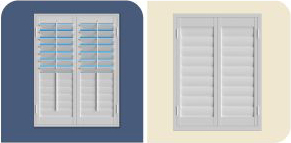
3 Ways Polywood Shutters Are Preferred Over Hollow Vinyl And Composite Shutters In Miami, FL
December 15, 2015
The market for plantation shutters in Miami is full of options. And when you want to know which non-wood shutter is the best for your home, some differences may be tough to recognize. You can unknowingly choose the wrong type and end up investing in shutters that won’t last. Wondering if Polywood® shutters - our best-selling solid polymer shutters - are a better investment than MDF (multi-density fiberboard) or hollow vinyl shutters? Find out the three ways Polywood shutters are preferred over composite shutters in Miami, FL to help you decide.
1. Polywood vs Composite Shutters Durability
Polywood shutters are fashioned from a first class solid polymer that ensures the most color-retention, durability, and rigidity than any other shutter you can find. This means the shutter louvers won’t warp as time goes by. However, composite shutters are made from a pressed-board core, enveloped in poly-vinyl. The vinyl wrapping the pressed board is likely to peel off from the core material readily. And this peeling happens even faster in humid, wet, and hot climates. Hollow vinyl shutters are another option for non-wood shutters. But they deteriorate the fastest due to the substance.Both forms of non-wood shutters are likely to warp and deteriorate when you consider all the weather conditions in Miami. Polywood is manufactured with UV inhibitors that divert heat. And with heat being the main offender in cracking the shutter louvers, Polywood is hands down the most durable plantation shutter you can buy.
2. Polywood vs Composite Shutters Color Fastness
Polywood shutters come in three premium white paints. Our paint finishes are baked on each piece at temperatures hotter than it will ever get in Miami, FL. Our patented finishing process applies UV inhibitors which guarantees the color doesn’t fade.
Other types of non-wood shutters are available in either low quality paint finish or no paint finish at all. In the majority of cases, the vinyl covering is the final color. Although it looks good when installed, this finish fades as time goes by. And as to hollow vinyls, some are painted. With the vinyl being a heat conductor, this seriously affects the finish over time.
3. Polywood vs Composite Shutters Energy Efficiency
Third party testing illustrates that Polywood shutters lead to reduction of heat transfer by up to 45% and block up to 30° of temperature. That’s how Polywood insulates up to 70% better than the top solid wood shutter.
These insulating properties are due to the solid polymer material Polywood shutters are made from. Yet what makes Polywood even more energy efficient than composite shutters is the weatherstripping on the panels and louvers. Just interlock the weatherstripping while closing the panels to get the tightest seal possible against the impact of the weather outside. No matter how far and wide you look, there isn’t a composite shutter that can give you the energy savings close to that of Polywood.
The Sunburst Team In Vegas Puts The Durability Of Polywood Shutters To The Test
Back in 2004, Sunburst Shutters Las Vegas had Polywood shutters fastened to the sides of their trucks as part of the graphics. These trucks were parked outside and endured all the weather conditions Las Vegas is famous for. That’s intense heat for almost five months each year!
The plantation shutters had been fastened to our trucks for more than 7 years at that point. Our team carried out a test on how well Polywood retained the color painted on it. The team wiped down the dusty Polywood shutter installed on the vehicle. And we compared it side by side to a new Polywood. We found the color to be unchanged. We didn’t see any discoloration or fading. This was further validation for the team that the Sunburst paint finish is the best in the market!
And since Polywood can endure that much heat and abuse on the side of a truck for more than 7 years, it’s undoubtedly the strongest shutter for your residence in Miami, FL.


